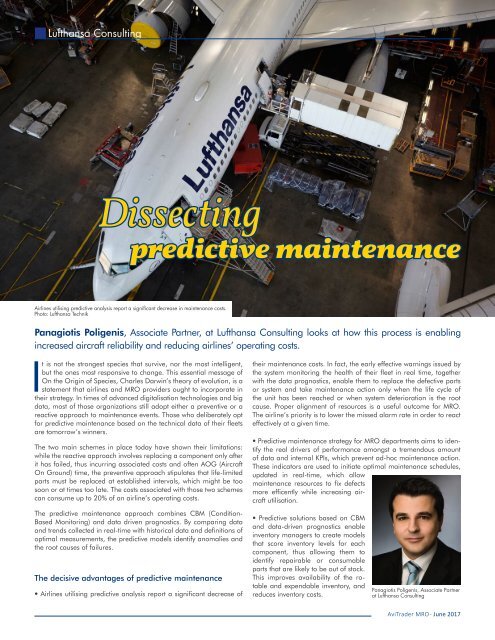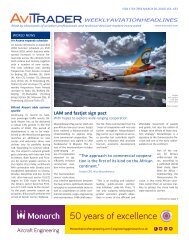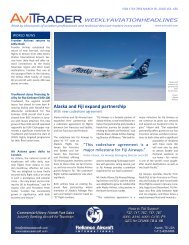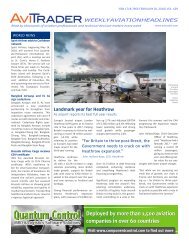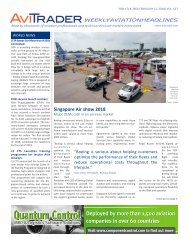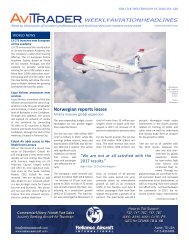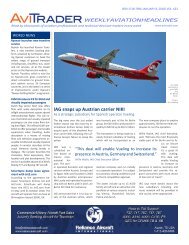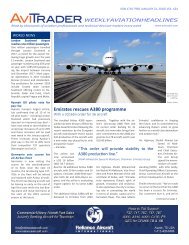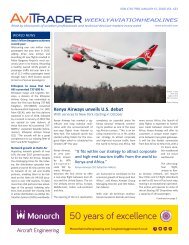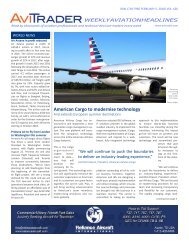AviTrader_Monthly_MRO_e-Magazine_2017-06
AviTrader_Monthly_MRO_e-Magazine_2017-06
AviTrader_Monthly_MRO_e-Magazine_2017-06
You also want an ePaper? Increase the reach of your titles
YUMPU automatically turns print PDFs into web optimized ePapers that Google loves.
Lufthansa Consulting<br />
37<br />
Dissecting<br />
predictive maintenance<br />
Airlines utilising predictive analysis report a significant decrease in maintenance costs.<br />
Photo: Lufthansa Technik<br />
Panagiotis Poligenis, Associate Partner, at Lufthansa Consulting looks at how this process is enabling<br />
increased aircraft reliability and reducing airlines’ operating costs.<br />
It is not the strongest species that survive, nor the most intelligent,<br />
but the ones most responsive to change. This essential message of<br />
On the Origin of Species, Charles Darwin’s theory of evolution, is a<br />
statement that airlines and <strong>MRO</strong> providers ought to incorporate in<br />
their strategy. In times of advanced digitalisation technologies and big<br />
data, most of those organizations still adopt either a preventive or a<br />
reactive approach to maintenance events. Those who deliberately opt<br />
for predictive maintenance based on the technical data of their fleets<br />
are tomorrow’s winners.<br />
The two main schemes in place today have shown their limitations:<br />
while the reactive approach involves replacing a component only after<br />
it has failed, thus incurring associated costs and often AOG (Aircraft<br />
On Ground) time, the preventive approach stipulates that life-limited<br />
parts must be replaced at established intervals, which might be too<br />
soon or at times too late. The costs associated with those two schemes<br />
can consume up to 20% of an airline’s operating costs.<br />
The predictive maintenance approach combines CBM (Condition-<br />
Based Monitoring) and data driven prognostics. By comparing data<br />
and trends collected in real-time with historical data and definitions of<br />
optimal measurements, the predictive models identify anomalies and<br />
the root causes of failures.<br />
The decisive advantages of predictive maintenance<br />
• Airlines utilising predictive analysis report a significant decrease of<br />
their maintenance costs. In fact, the early effective warnings issued by<br />
the system monitoring the health of their fleet in real time, together<br />
with the data prognostics, enable them to replace the defective parts<br />
or system and take maintenance action only when the life cycle of<br />
the unit has been reached or when system deterioration is the root<br />
cause. Proper alignment of resources is a useful outcome for <strong>MRO</strong>.<br />
The airline’s priority is to lower the missed alarm rate in order to react<br />
effectively at a given time.<br />
• Predictive maintenance strategy for <strong>MRO</strong> departments aims to identify<br />
the real drivers of performance amongst a tremendous amount<br />
of data and internal KPIs, which prevent ad-hoc maintenance action.<br />
These indicators are used to initiate optimal maintenance schedules,<br />
updated in real-time, which allow<br />
maintenance resources to fix defects<br />
more efficently while increasing aircraft<br />
utilisation.<br />
• Predictive solutions based on CBM<br />
and data-driven prognostics enable<br />
inventory managers to create models<br />
that score inventory levels for each<br />
component, thus allowing them to<br />
identify repairable or consumable<br />
parts that are likely to be out of stock.<br />
This improves availability of the rotable<br />
and expendable inventory, and<br />
reduces inventory costs.<br />
Panagiotis Poligenis, Associate Partner<br />
at Lufthansa Consulting<br />
<strong>AviTrader</strong> <strong>MRO</strong> - June <strong>2017</strong>


